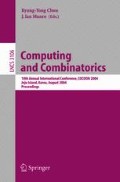Abstract
A cut (A,B) (where B = V–A) in a graph G(V,E) is called internal, iff there exists a node x in A which is not adjacent to any node in B and there exists a node y ∈ B such that it is not adjacent to any node in A. In this paper, we present a theorem regarding the arrangement of cliques in a chordal graph with respect to its internal cuts. Our main result is that given any internal cut (A,B) in a chordal graph G, there exists a clique with κ(G) + 1 nodes (where κ(G) is the vertex connectivity of G) such that it is (approximately) bisected by the cut (A,B). In fact we give a stronger result: For any internal cut (A,B) of a chordal graph, for each i, 0 ≤ i ≤ κ(G) +1, there exists a clique K i such that |K i | = κ(G) + 1, |A ∩ K i | = i and |B ∩ K i | = κ(G) + 1 – i.
An immediate corollary of the above result is that the number of edges in any internal cut (of a chordal graph) should be Ω (k 2), where κ(G) = k. Prompted by this observation, we investigate the size of internal cuts in terms of the vertex connectivity of the chordal graphs. As a corollary, we show that in chordal graphs, if the edge connectivity is strictly less than the minimum degree, then the size of the mincut is at least \( \frac{\kappa(G)(\kappa (G)+1)}{2}\), where κ(G) denotes the vertex connectivity. In contrast, in a general graph the size of the mincut can be equal to κ(G). This result is tight.
Access this chapter
Tax calculation will be finalised at checkout
Purchases are for personal use only
Preview
Unable to display preview. Download preview PDF.
References
Buneman, P.: A characterisation of rigid circuit graphs. Discrete Mathematics 9, 205–212 (1974)
Chandran, L.S.: Edge connectivity vs vertex connectivity in chordal graphs. In: Wang, J. (ed.) COCOON 2001. LNCS, vol. 2108, p. 384. Springer, Heidelberg (2001)
Sunil Chandran, L.: A linear time algorithm for enumerating all the minimum and minimal separators of a chordal graph. In: Wang, J. (ed.) COCOON 2001. LNCS, vol. 2108, pp. 308–317. Springer, Heidelberg (2001)
Chandran, L.S., Kavitha, T., Subramanian, C.R.: Isoperimetric inequalities and the width parameters of graphs. In: Warnow, T.J., Zhu, B. (eds.) COCOON 2003. LNCS, vol. 2697, pp. 385–395. Springer, Heidelberg (2003)
Chandrasekaran, R., Tamir, A.: Polynomially bounded algorithms for locating p-centres on a tree. Math. Programming 22, 304–315 (1982)
Chartrand, G., Harary, F.: Graphs with prescribed connectivities. In: Erdos, P., Katona, G. (eds.) Theory of Graphs, pp. 61–63. Akademiai Kiado, Budapest (1968)
Golumbic, M.C.: Algorithmic Graph Theory And Perfect Graphs. Academic Press, New York (1980)
Harary, F.: Graph Theory. Addison-Wesley, Reading (1969)
Kloks, T.: Treewidth. LNCS, vol. 842. Springer, Heidelberg (1994)
Mohring, R.H.: Graph Problems Related To Gate Matrix Layout And PLA Folding. In: Computational Graph Theory, pp. 17–52. Springer, Wein (1990)
Papadimitriou, C., Yannakakis, M.: Scheduling interval ordered tasks. SIAM Journal of Computing 8, 405–409 (1979)
Rose, D.: Triangulated graphs and the elimination process. J. Math. Ana. Appl. 32, 597–609 (1970)
Rose, D.: A graph theoretic study of the numerical solution of sparse positive definite systems of linear equations. In: Graph Theory and Computing, pp. 183–217. Academic Press, London (1972)
Whitney, H.: Congruent graphs and the connectivity of graphs. American J.Math 54, 150–168 (1932)
Yannakakis, M.: Computing the minimum Fill–in is NP–complete. SIAM J. on Alge. Discre. Math. 2, 77–79 (1981)
Author information
Authors and Affiliations
Editor information
Editors and Affiliations
Rights and permissions
Copyright information
© 2004 Springer-Verlag Berlin Heidelberg
About this paper
Cite this paper
Chandran, L.S., Narayanaswamy, N.S. (2004). On the Arrangement of Cliques in Chordal Graphs with Respect to the Cuts. In: Chwa, KY., Munro, J.I.J. (eds) Computing and Combinatorics. COCOON 2004. Lecture Notes in Computer Science, vol 3106. Springer, Berlin, Heidelberg. https://doi.org/10.1007/978-3-540-27798-9_18
Download citation
DOI: https://doi.org/10.1007/978-3-540-27798-9_18
Publisher Name: Springer, Berlin, Heidelberg
Print ISBN: 978-3-540-22856-1
Online ISBN: 978-3-540-27798-9
eBook Packages: Springer Book Archive

